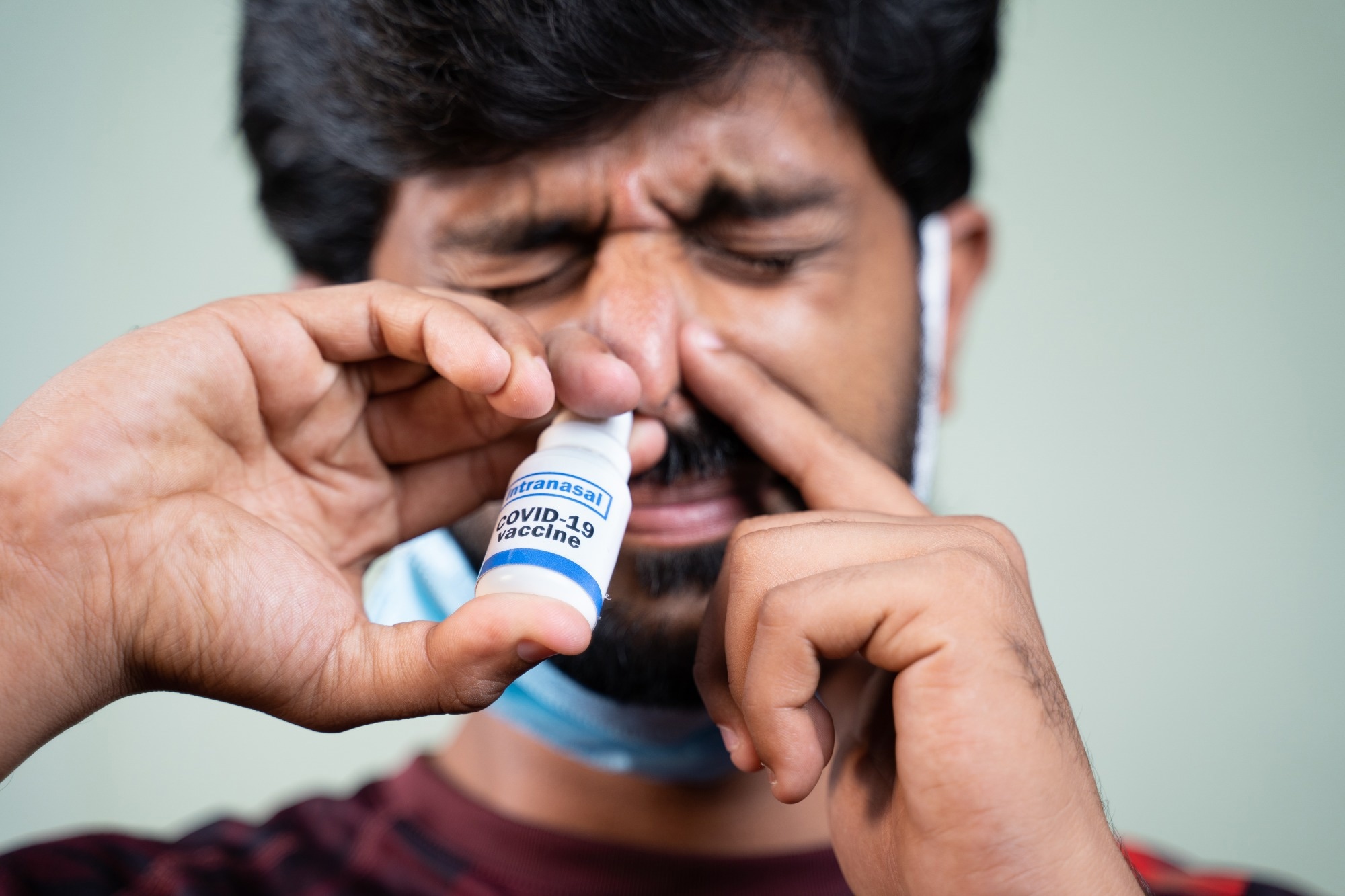 By Ankit SinghReviewed by Lauren HardakerMay 28 2025
By Ankit SinghReviewed by Lauren HardakerMay 28 2025The COVID-19 pandemic highlighted the need for adaptable and scalable vaccine technologies. While mRNA vaccines have improved disease prevention, most are delivered by intramuscular injection, which may not effectively prevent infections that begin at mucosal surfaces, such as the nose and lungs. For respiratory pathogens, this limits protection at the initial site of infection.
Inhalable nanovaccines are being investigated as an alternative approach. These formulations are designed to activate immune responses in the respiratory tract, where pathogens often enter, by delivering antigens to local immune cells through mucosal immunization.

Image credit: WESTOCK PRODUCTIONS/Shutterstock.com
Mechanisms of Delivery: How Nanocarriers Work
Inhalable nanovaccines utilize engineered nanoparticles to deliver antigens or genetic material to immune cells in the respiratory tract. These nanocarriers are designed to overcome biological barriers, such as mucus layers and enzymatic degradation, while targeting antigen-presenting cells (APCs) like dendritic cells and alveolar macrophages to enhance immune activation.
Lipid Nanoparticles (LNPs)
LNPs, widely used in mRNA COVID-19 vaccines, are being adapted for inhalable delivery. Their formulation includes ionizable lipids, cholesterol, and polyethylene glycol (PEG), which protect messenger RNA (mRNA) and facilitate its uptake by cells.
A recent study in the Journal of the American Chemical Society demonstrated that modified LNPs remained stable during nebulization and successfully delivered mRNA to the lungs of mice, leading to uniform protein expression without inducing inflammation.1 An additional modification involving cationic lipids improved targeting of lung tissues.1,2
Polymer-Based and Biomimetic Systems
Polymeric nanoparticles, such as those made from polylactic-co-glycolic acid (PLGA), can be designed for controlled release and enhanced immune response. Researchers have also developed virus-like nanovaccines that mimic the structural features of pathogens.
One biomimetic COVID-19 vaccine combined pulmonary surfactant liposomes with SARS-CoV-2 spike proteins, promoting mucosal immunoglobulin A (IgA) responses in preclinical models. Similarly, mussel-inspired nanoparticles with mucoadhesive properties have shown promise in penetrating lung mucus to deliver anticancer drugs, a strategy adaptable for vaccines.3,4
Hybrid Nanoplatforms
Hybrid platforms combine synthetic and biological components to improve vaccine performance. One approach involved fusing nanovesicles expressing SARS-CoV-2 antigens with adjuvant-loaded liposomes. This formulation activated alveolar macrophages and led to the production of both systemic immunoglobulin G (IgG) and mucosal IgA, suggesting broader protection across different viral variants.5
Key Advantages of Inhalable Nanovaccines
Needle-Free Delivery
Inhalable vaccines avoid the risks associated with injections, including needle-related injuries and infections. They may also be more acceptable to people with needle phobia and are easier to administer in mass vaccination efforts. Convidecia Air, an inhalable COVID-19 vaccine approved in China, demonstrated high user acceptability.5
Inhalable formats could also support self-administration, which is especially relevant in regions with limited healthcare infrastructure.6
Mucosal Immunity
Unlike injectable vaccines, which mainly stimulate systemic IgG, inhalable vaccines promote the production of secretory immunoglobulin A (sIgA) at mucosal surfaces. sIgA helps neutralize pathogens before they can infect host cells, reducing transmission. A recent study published in Signal Transduction and Targeted Therapy showed that intranasal RNA vaccines can generate lung-resident memory T cells and sIgA, providing superior protection against respiratory viruses compared to intramuscular shots.2,6
Enhanced Stability and Distribution
Many nanovaccine platforms, including LNPs and polymer-based systems, can be freeze-dried (lyophilized), allowing storage at 4°C or lower without cold-chain dependency. For example, researchers at the University of Wisconsin-Madison developed a lyophilized avian influenza nanovaccine stable for 30 days at -20 °C, indicating its suitability for use in low-resource or remote settings.7
Current Research and Target Diseases
Recent advancements in inhalable nanovaccines are transforming disease prevention and treatment. Current targets include COVID-19, influenza, tuberculosis, and lung cancer.
COVID-19
Inhalable vaccine platforms have been applied extensively in COVID-19 research. Scientists have developed a hybrid nanovaccine that combines receptor-binding domain (RBD)-expressing nanovesicles with monophosphoryl lipid A (MPLA) adjuvant liposomes. This combination has been shown to elicit potent neutralizing antibodies against multiple variants, including Omicron, in preclinical models.
Additionally, a biomimetic vaccine designed to mimic the structure of the virus induced mucosal sIgA responses in mice that exceeded those generated by intramuscular vaccines.3,5
Influenza
Conventional influenza vaccines have limited efficacy due to frequent antigenic drift. Nanoparticle-based strategies aim to improve coverage by delivering conserved antigens or mosaic hemagglutinin (HA) proteins. A study from the University of Wisconsin–Madison developed a mosaic HA nanovaccine capable of eliciting cross-reactive immune responses in poultry against diverse high pathogenic avian influenza (HPAI) strains. This approach may be adaptable to human vaccination.7
Tuberculosis (TB)
TB primarily infects the lungs, making inhalable vaccines an ideal option. Studies have shown that PLGA nanoparticles loaded with Mycobacterium tuberculosis (Mtb) antigens can stimulate lung-resident immune cells, resulting in a greater reduction in bacterial load compared to injectable Bacillus Calmette-Guérin (BCG) vaccines.8
Lung Cancer
In addition to their potential for treating infections, inhalable nanovaccines are also being explored in oncology. Recent studies have shown that intranasal RNA vaccines encapsulated in lipid nanoparticles enhanced with cationic lipid 1,2-dioleoyl-3-trimethylammonium propane (DOTAP) can reprogram cytotoxic T cells to target lung tumors in mice. This approach has doubled the survival rates in mice without causing systemic toxicity.2
Download your PDF copy now!
Formulation Challenges and Innovations
Researchers are developing new strategies to address technical challenges associated with inhalable nanovaccine delivery, focusing on stability, lung retention, and immune safety.
Overcoming Mucosal Barriers
The lung’s mucus layer and mucociliary clearance rapidly remove inhaled particles. To address this, researchers developed nanoparticles with mucoadhesive surfaces, such as those coated with cysteine-modified mussel proteins, which prolong retention in the lungs.3
Stability During Nebulization
Nebulization can damage nanoparticles, reducing efficacy. A recent study published in the Journal of the American Chemical Society solved this by incorporating zwitterionic polymers into LNPs, which prevented aggregation and maintained mRNA integrity during aerosolization.1
Balancing Immunogenicity and Safety
While adjuvants such as MPLA enhance immune responses, excessive activation can lead to inflammation. Hybrid nanovaccines using pH-sensitive polymers have been developed to provide more controlled adjuvant release, aiming to avoid excessive cytokine responses while preserving efficacy.5
The Future of Inhalable Nanovaccines
Future research will likely see inhalable nanovaccines targeting a broader range of diseases, from RSV to antimicrobial-resistant pathogens. Emerging directions include the use of AI-based models to optimize nanoparticle design, multivalent formulations that deliver several antigens simultaneously, and thermostable formulations in powder form to support use in low-resource or emergency settings.7,8
Inhalable nanovaccines represent an evolving area of vaccine technology. By enabling mucosal immune responses and offering needle-free administration, they may expand access to immunization and improve outcomes for respiratory diseases. Although formulation and distribution challenges remain, continued research and cross-sector collaboration may support the broader implementation of inhalable vaccine platforms as part of future public health strategies.
If you want to learn more about inhalable nanovaccines and related advances in drug delivery, immunology, and nanotechnology, subscribe to our expert-curated Nanomedicine Newsletter.
References and Further Reading
- Jiang, A. Y. et al. (2024). Zwitterionic Polymer-Functionalized Lipid Nanoparticles for the Nebulized Delivery of mRNA. Journal of the American Chemical Society. DOI:10.1021/jacs.4c11347. https://pubs.acs.org/doi/full/10.1021/jacs.4c11347
- Li, H. et al. (2025). Intranasal prime-boost RNA vaccination elicits potent T cell response for lung cancer therapy. Signal Transduction and Targeted Therapy, 10(1), 1-15. DOI:10.1038/s41392-025-02191-1. https://www.nature.com/articles/s41392-025-02191-1
- Zheng, B. et al. (2021). Inhalable nanovaccine with biomimetic coronavirus structure to trigger mucosal immunity of respiratory tract against COVID-19. Chemical Engineering Journal, 418, 129392. DOI:10.1016/j.cej.2021.129392. https://www.sciencedirect.com/science/article/pii/S1385894721009803
- Inhalable therapy uses mussel-inspired nanoparticles to target lung cancer cells. (2025). Phys.org. https://phys.org/news/2025-01-inhalable-therapy-mussel-nanoparticles-lung.html
- Wang, S. et al. (2024). Inhalable hybrid nanovaccines with virus-biomimetic structure boost protective immune responses against SARS-CoV-2 variants. Journal of Nanobiotechnology, 22, 76. DOI:10.1186/s12951-024-02345-3. https://jnanobiotechnology.biomedcentral.com/articles/10.1186/s12951-024-02345-3
- Kiyono, H., & Ernst, P. B. (2025). Nasal vaccines for respiratory infections. Nature, 641(8062), 321-330. DOI:10.1038/s41586-025-08910-6. https://www.nature.com/articles/s41586-025-08910-6
- Sukumaran, P. (2025). Novel NanoVaccines Against Emerging Isolates of Avian Influenza. Nanovaccine Institute, Iowa State University. https://nanovaccine.iastate.edu/novel-nanovaccines-against-emerging-isolates-of-avian-influenza/
- Saleh, M. et al. (2025). Revolutionizing Nanovaccines: A New Era of Immunization. Vaccines, 13(2), 126. DOI:10.3390/vaccines13020126. https://www.mdpi.com/2076-393X/13/2/126
Disclaimer: The views expressed here are those of the author expressed in their private capacity and do not necessarily represent the views of AZoM.com Limited T/A AZoNetwork the owner and operator of this website. This disclaimer forms part of the Terms and conditions of use of this website.